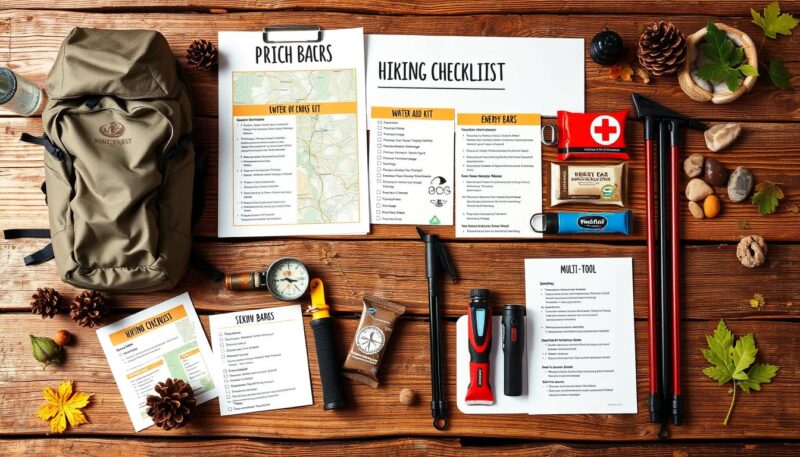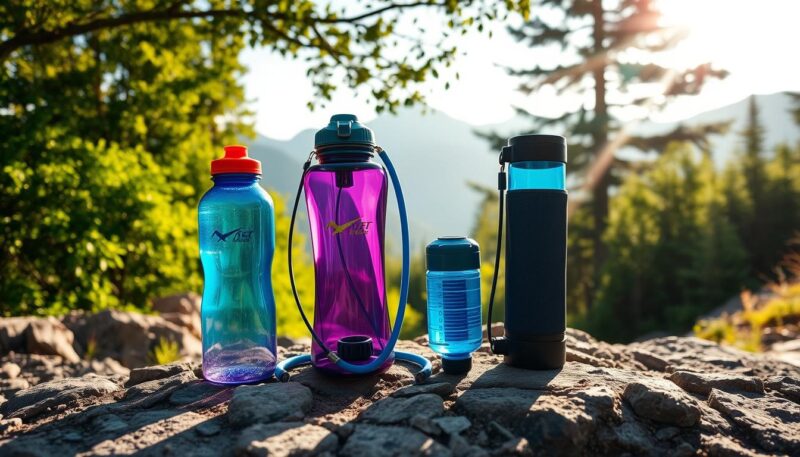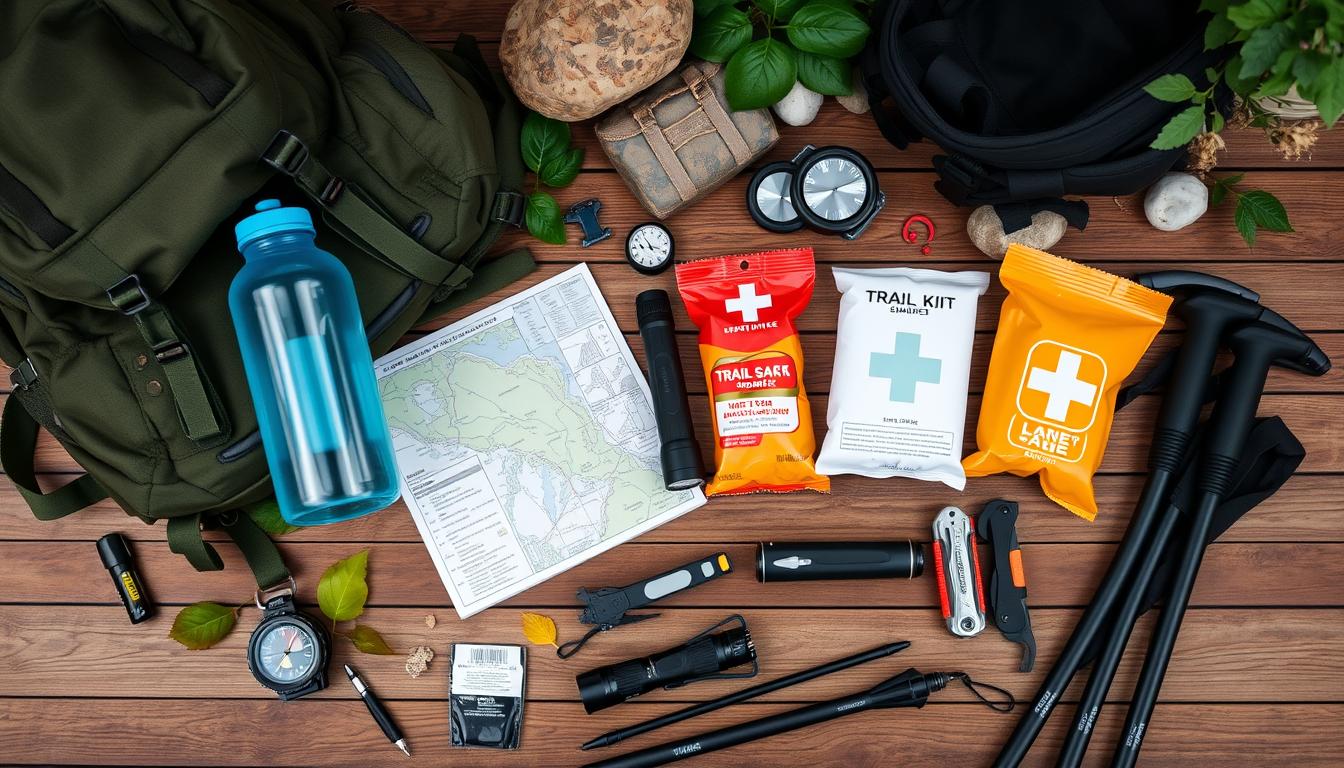Embarking on a day hike invites you to connect with nature, embrace physical activity, and experience breathtaking views. Whether you’re trekking a local trail or exploring a more challenging wilderness route, being equipped with the necessary hiking essentials can make all the difference in ensuring a safe and enjoyable trip. You’ll need to consider your clothing, gear, hydration, nutrition, and safety items to be well-prepared for unexpected situations and to fully appreciate your journey.
Your ultimate goal should be an enjoyable hike where both comfort and safety are prioritized. That means carefully selecting every item you pack. From the right type of footwear to reliable navigation tools, every piece of hiking gear plays a crucial role. As you prepare, keep in mind the varied conditions you might face and tailor your hiking essentials accordingly. Your adventure starts here by knowing precisely what to pack for a hike.
Key Takeaways
- Select proper clothing and suitable footwear to ensure comfort and protection on your hike.
- Hydration is vital; consider using hydration packs for convenience.
- Carry energy-sustaining snacks like granola bars and trail mix to keep your energy up.
- A well-stocked first aid kit is essential for addressing minor injuries.
- Ensure you have a dependable navigation tool, such as the AllTrails app, to stay on track.
Choosing the Right Clothing and Footwear
Embarking on a hike requires more than just the will to explore; it demands appropriate gear to ensure comfort, safety, and enjoyment. The right combination of clothing and footwear can make or break your outdoor adventure. Let’s break down some essential choices to consider.
Hiking Shoes and Boots
Your feet are your most valuable asset on the trail, and selecting the right hiking shoes or boots is crucial. Hiking boots, like the popular Salomon X Ultra 4 GTX, offer excellent ankle support and traction on uneven terrain, which is why 75% of hikers prefer them over trail runners or sandals. Durable hiking boots can range from $120 to $250, depending on the technicality of your hike. For those who prefer a lighter option, trail runners are great for shorter hikes or smoother trails. Remember, investing in quality footwear ensures that you’ll log many comfortable miles on the trail.
Additionally, pairing your hiking shoes with high-quality socks, such as those from Darn Tough, can significantly reduce the occurrence of blisters, ensuring your feet stay comfortable over long distances.
Appropriate Layers and Weather-Resistant Gear
Layering is vital for regulating body temperature and adapting to changing weather conditions. It is recommended to use synthetic materials like nylon and polyester, as they are quick-drying and offer excellent moisture management. Patagonia’s Capilene line excels in moisture control, making it ideal for your base layer. When hiking in cooler climates or anticipating rain, a waterproof jacket, such as the Patagonia Torrentshell, can be a game-changer, protecting you from the elements while keeping you dry.
Women often prefer hiking leggings for their comfort and flexibility, while those opting for shorts find elastic waistbands beneficial for mobility. When choosing tops, moisture-wicking and breathable properties are key. For summer hikes, consider garments made with mesh paneling to enhance breathability, thus ensuring comfort even in warmer weather.
Sun Protection Clothing
Sun protection is an essential aspect of hiking that should not be overlooked. Wearing a brimmed hat, sunglasses, and applying sunscreen can protect you from harmful UV rays. Additionally, clothing that offers UV protection is recommended, such as the Mountain Hardwear Crater Lake Hoody, which is lightweight and breathable, ensuring comfort while shielding you from the sun. As noted, 85% of hikers choose darker colors for hiking shorts, as they tend to be more durable and easier to keep clean.
Being well-prepared with the right outdoor clothing and hiking footwear can significantly enhance your hiking experience, allowing you to focus on the breathtaking sights and sounds of nature.
Essential Hiking Equipment
When planning a hike, having the right equipment is crucial to ensure safety, comfort, and enjoyment. This section outlines the key items you should include in your hiking checklist.
Daypack or Hydration Pack
A reliable daypack, such as the Osprey Talon 22, is indispensable for organizing and carrying your hiking essentials. Ensure your pack is at least 25L to accommodate everything needed for a successful day hike. Additionally, a hydration system, like a Nalgene Wide Mouth Sustain, is recommended to help you stay hydrated. Remember, staying hydrated is crucial, with a recommendation of at least 2 liters of water per day hike.

Navigation Tools
Navigation tools are vital for staying on track during your hike. A GPS device, such as the Garmin inReach Mini 2, provides real-time tracking and easier navigation. It’s important to carry backup tools like a map and compass to ensure you’re prepared for any electronic failures. These tools help you maintain direction and safety, making them essential additions to your hiking checklist.
Trekking Poles
Trekking poles can significantly improve your hiking experience by providing balance and reducing stress on your knees, especially during longer hikes. The Black Diamond Pursuit trekking poles are an excellent choice for stability and support. They also assist in navigating challenging terrain, making them a valuable component of your hiking gear.
Below is a detailed table of recommended hiking equipment:
| Equipment | Brand/Model | Price |
|---|---|---|
| Daypack | Osprey Talon 22 | $160 |
| Hydration System | Nalgene Wide Mouth Sustain | $17 |
| Navigation Tool | Garmin inReach Mini 2 | $400 |
| Trekking Poles | Black Diamond Pursuit | $150 |
By ensuring you have these essential items, you can greatly enhance your hiking experience, from efficient navigation with a GPS device to maintaining hydration and balance with a quality daypack and trekking poles. Always refer to your hiking checklist before setting out to avoid missing any crucial gear.
Hydration: Staying Hydrated on the Trail
Ensuring sufficient hydration is fundamental for any hike, with proper measures to maintain fluid levels and electrolyte balance. Hydration is particularly critical since older adults have, on average, 10% less fluid in their bodies than younger adults, making them more susceptible to dehydration.

Water Bottles and Hydration Bladders
Carrying both water bottles and a hydration bladder can significantly enhance your hydration system. Reliable water bottles like the Hydro Flask with a leakproof straw cap assure easy access to water. Additionally, integrating a hydration bladder into your pack, such as the CamelBak Rogue, enables hands-free hydration, which is particularly beneficial during strenuous sections of your hike.
The author suggests bringing enough water to last a few days, especially for individuals who sweat heavily.
Drinking one-half to one quart of water every hour of hiking helps replenish fluids and electrolytes, especially in warmer environments. Portable filters like the RapidPure Purifier+ Insulated Steel Bottle can also be beneficial, allowing you to safely use water from surrounding sources.
Water Filters or Chemical Treatments
For extended hikes where water sources are abundant, using a water filter is imperative for safe consumption. Products like the Sawyer Mini Water Filtration System or chemical treatments, such as iodine tablets, effectively eliminate harmful bacteria and viruses. These water filters are not only lightweight but also easy to use, making them an essential part of your hiking hydration system. Planning for emergency hydration by knowing the location of streams and having suitable water filters can be life-saving.
Moreover, utilizing electrolyte replacement tablets from brands like GU Energy or Hammer Nutrition during hikes can help maintain your body’s electrolyte balance, enhancing your overall hydration strategy. In addition, the author typically drinks water with electrolyte tablets during strenuous hikes to ward off dehydration.
- For a short hike, bring at least two large water bottles.
- For longer and more demanding trails, carry a hydration bladder along with extra water bottles and a reliable water filter.
- Use a combination of plain water and water enhanced with electrolyte tablets for optimal hydration.
In summary, a well-thought-out hydration system, complemented by a practical hydration bladder and effective water filter, is crucial for maintaining hydration and ensuring a safe and enjoyable hiking experience.
Food and Snacks
Nutrition plays a vital role in ensuring you have the energy to complete your hike. Packing the right hiking snacks is not just about satisfying hunger, but also about maintaining energy levels and staying hydrated. Below, we explore ideal options to fuel your adventure.
Energy Bars and Trail Mix
Energy bars offer lightweight nutrition and are convenient to carry. Brands like Clif Bar and RXBAR provide wholesome ingredients and various flavors to suit different preferences. For a homemade touch, try making trail mix:
- Homemade Trail Mix: Combine one cup of roasted almonds, one cup of roasted cashews, ½ cup of organic dried cherries, ¼ cup of organic dried pineapple, and one cup of dark chocolate chunks.
- Kid-Friendly Trail Mix: Mix one cup of roasted peanuts, ½ cup of roasted almonds, ½ cup of organic dried blueberries or raisins, ½ cup of white chocolate chunks, and ½ cup of peanut-butter M&Ms.
Electrolytes
Ensuring you replenish lost minerals is crucial, especially during strenuous hikes. Electrolyte supplements like NUUN and Liquid I.V. are excellent choices to help combat dehydration. They are easy to pack and can be added to your water for an instant boost. Proper hydration, coupled with electrolyte solutions, can prevent heat exhaustion.
Lunch Items
Lunch during a hike should be both nourishing and easy to prepare. Here are some suggestions:
- PB & J: Use extra crunchy peanut butter, strawberry jam, and a good, textured bread with nuts or seeds to keep you energized.
- Beef Jerky: Opt for jerky with simple ingredients to avoid added preservatives, sugar, and flavors.
- DIY No-Bake Choco-Nut Energy Bites: Combine one cup of rolled oats, ¾ cup of almond butter, 1/3 cup of honey, ½ cup of shredded coconut, ½ cup of chocolate chips, 1/3 cup of chopped toasted almonds, and ¼ cup of ground flaxseed for a delightful snack.
If you’re embarking on a cold-weather hike, consider packing a backpacking stove and fuel for hot meal options. These can warm you up and provide a morale boost in chilly conditions. Remember, thoughtful meal planning ensures sustained energy levels and balanced nutrition throughout your journey.
What to Bring on a Hike? The Must-Have Items for Safety
Ensuring hiking safety is paramount, and preparing with the right gear can make all the difference. From addressing minor scrapes to alerting others in emergencies, a well-thought-out safety kit is indispensable. Here’s a breakdown of three essential items every hiker should pack to stay safe on the trail.
First Aid Kit
A compact but comprehensive first aid kit is a non-negotiable item for any hike. It should contain essentials like bandages, antiseptics, and pain relievers to handle minor injuries. Items like blister treatments, tweezers, and emergency medication can also be vital. Brands such as Adventure Medical Kits offer lightweight solutions that don’t skimp on necessary supplies. Ensuring that your first aid kit is fully stocked and tailored to your specific needs can provide peace of mind and practical aid when needed most.
Emergency Whistle
Another crucial item for hiking safety is an emergency whistle. This small but mighty tool can be a lifesaver in distress situations, helping you to signal for help when needed. A whistle’s sound can travel farther than a human voice, especially in rugged terrains or dense forests, where visibility might be an issue. Many backpacks and outdoor gear come with built-in whistles, but carrying a separate, high-decibel whistle like the Fox 40 can offer an extra layer of security.
Headlamp or Flashlight
Proper illumination is vital for any hike, especially as trails can sometimes extend into the evening or pass through dimly lit sections. A reliable headlamp, such as the Petzl Actik Core, offers hands-free lighting and long battery life, making it perfect for navigating in low-light conditions. Flashlights are also effective, but ensure they’re durable and have spare batteries. Carrying a source of light isn’t just about convenience; it can help prevent mishaps and make signaling easier if you encounter trouble after dark.
FAQ
What are the essential items to pack for a day hike?
The must-have items for every day trip includes a quality daypack, hydration system, sun protection, a first aid kit, light snacks, a hiking map, trekking poles, a lightweight jacket, an emergency whistle, and navigation tools.
What type of clothing and footwear should I choose for hiking?
Proper outdoor clothing and footwear are crucial. Opt for durable and comfortable hiking shoes or boots like Salomon X Ultra 4 GTX, layer your clothing according to the weather, and choose weather-resistant gear such as Patagonia’s Capilene for moisture control. For sun protection, consider lightweight and breathable options like the Mountain Hardwear Crater Lake Hoody.
Why is a daypack important for a hike?
A quality daypack, like the Osprey Talon 22, ensures comfort and efficient organization of your hiking essentials. It helps distribute weight evenly, has compartments for easy access, and often includes hydration bladder systems.
What navigation tools should I bring for a hike?
Bring reliable navigation tools such as maps, a compass, and a GPS device. The Garmin inReach Mini satellite communicator is highly recommended for remote areas where cell reception is unavailable.
How can I stay hydrated on the trail?
Use reliable water bottles like the Hydro Flask or Nalgene bottles and hydration bladders integrated into packs like the CamelBak Rogue. Carry portable water filters or chemical treatments, such as the Sawyer Squeeze, to ensure safe drinking water from natural sources.
What kind of snacks and meals are ideal for hiking?
Opt for quick, energy-boosting snacks like granola bars, energy chews, and trail mix. Include electrolyte solutions such as NUUN or Liquid I.V. for hydration. Choose nourishing and satisfying lunch items and pack extra snacks for unexpected situations.
Why is safety gear essential for hiking?
Safety gear, including a first aid kit with bandages and antiseptic, an emergency whistle for signaling, and adequate lighting like headlamps such as the Petzl Actik Core, are crucial for handling emergencies, signaling for help, and navigating in low light.
Source Links
- https://www.erinexploring.com/blog/day-hiking-essentials
- https://www.kuhl.com/borninthemountains/hiking-checklist-what-to-bring-on-a-hike?srsltid=AfmBOooFBjmZyOnonqJsJ_HzfEC2l79c4iH4wA1b7RrrY9hHBigwC937
- https://www.wta.org/go-outside/new-to-hiking/hiking-101-1/hiking-101-part-2-selecting-clothing-and-gear
- https://bearfoottheory.com/what-to-wear-hiking/
- https://www.backpacker.com/skills/hiking-outfit-how-to-pick/
- https://www.kuhl.com/borninthemountains/hiking-checklist-what-to-bring-on-a-hike?srsltid=AfmBOoqYmmKUrl7etKgRBzQwy0GBq4q9IFmjr-EXxYmR5EDtMn1Brse7
- https://www.switchbacktravel.com/info/day-hiking-checklist
- https://www.nps.gov/articles/10essentials.htm
- https://adventuremedicalkits.com/blogs/news/5-tips-to-prevent-dehydration-while-hiking
- https://www.hikingwithshawn.com/hiking-hydration/
- https://www.jauntyeverywhere.com/day-hiking-food-for-the-trail/
- https://nattieupnorth.com/outdoors-travel/my-go-to-trail-snacks-for-your-next-day-hike
- https://www.kuhl.com/borninthemountains/hiking-checklist-what-to-bring-on-a-hike?srsltid=AfmBOood7RDBOGHmVvwMCRNjIfOKmkUA8W0NkB-0UyRAQAkCmR6STJxd
- https://www.outdoors.org/resources/amc-outdoors/outdoor-resources/the-10-essentials-what-to-pack-for-a-backcountry-hike/
- https://www.lensofjen.org/an-essential-survival-kit-for-beginning-hikers/

